Thomas
New member
- Joined
- Oct 11, 2010
- Messages
- 2
Hello Quadlovers 
My name is Thomas and I'm from the Netherlands. With my 28 years of age I am convinced I was born at least 20 years too late; missed the wonderfull glory days of true analogue sound; buying records instead of videogames and listening to Pink Floyd instead of Lady Gaga. Cleaning your stylus like it was at least as precious as a few weeks of hard labor and swiftly run to the store for this month's new "Elektor" which features a very cool MOSFET power amplifier whose parts will be at least another two months worth of saving up. Well, in those days, it was! At least, I guess so or I like to think so
I've been aware of Quadraphonicquad.com for a while now, but Quadraphonic sound has always been kind of a sidetrack for me. Until recently my interest in this matter has been quite low; mostly due to the minor availability and high prices of those QS and SQ modulated vinyl frisbees
I have, however, a born addiction for vintage and analogue sound. For more than ten years now, I run my website www.mfbfreaks.com which focusses exclusively on the dutch Philips brand in the period of 1969-1979. That is, before "plastic fantastic" started to spread through the market. The so called "Motional Feedback" system was very, very revolutionair back in 1973. It combined two worlds which until then were unthinkable to go together. By implanting a piezo electric sensor in the woofer of the loudspeaker cabinet, Philips was able to feed the actual cone movement back to the amplifier where it was compared with the original source signal and, if necessery, corrected. This way it became possible to greatly reduce the resonance frequency of the woofer and, thus, greatly improve bass response in the 20 - 60 Hz range. In normal English, a relatively small speaker was able to produce the sound that would normally require a cabinet at least two or three times its size, with accompanying bigger woofer. A miracle was born! Philips also decided to build the power amplifier inside the cabinet, making this an active loudspeaker system. One of the first for home use, that's for sure! Built-in filters, sensitivity control and built-in automatic power control were added and there it was; Philips Motional Feedback Loudspeakers; Small in size; Big in performance! How wonderfull is that?
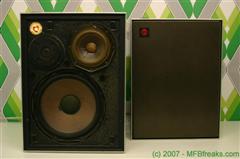
The model shown above, 22RH532, was released in 1973. And now it gets interesting also for you guys In those days, Quadraphonic Sound Reproduction was a great novelty. Although hesitantly gaining popularity because of all those different methods and media, Philips also saw a chance to use the brand new MFB (Motional FeedBack) techniques to be smoothly integrated into this super duper modern reproduction system. Where other brands had to struggle building large and heavy receivers with multiple power amplifiers in a back breaking device, Philips didn't need all that; they had their amps ready integrated in the speaker cabinets!
In those days, Quadraphonic Sound Reproduction was a great novelty. Although hesitantly gaining popularity because of all those different methods and media, Philips also saw a chance to use the brand new MFB (Motional FeedBack) techniques to be smoothly integrated into this super duper modern reproduction system. Where other brands had to struggle building large and heavy receivers with multiple power amplifiers in a back breaking device, Philips didn't need all that; they had their amps ready integrated in the speaker cabinets!
Theoretically they could simply take their already popular and famous GA212 record player...
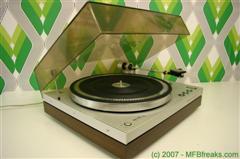
...add two stereo MFB preamps type 22RH551 with those great round VU meters...
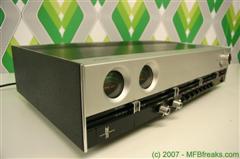

...maybe add an AM-FM tuner for fun, like the 22RH651 they already had hangin' round...
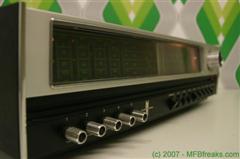
...stirr and shake a little so a smooth blend of 1973 High Tech Audio Equipment is created and, voila...
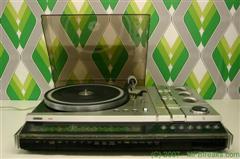
There you have it! The Philips 22RH832 Four Channel High Fidelity Quadraphonic AM-FM Stereo Receiver Record Player with built-in 4-channel MFB pre-amplifier, SQ decoder and - hence the commercials - send/return DIN plug for the use of an external CD4 decoder! Well, if that's not gonna make daddy drool all over the place, what else will? Not even the newest DAF 66 with variomatic Sports Edition! Its built-in decoder offers instant SQ decoding but since the Shibata shaped stylus with special GP422 "Quadro" cartridge was added, also CD-4 decoding is prepared for. All you needed was an external, third party decoder. Probably a copyright issue; anyone know anything about that?
So far, so good I've been loving, collecting and serviceing (is that even a word?) vintage Philips audio for about ten years now and, although the 22RH832 receiver entered my collection years ago, I only now am really really wanting to actually hear that Quadraphonic sound! I am currently working on two RH832's for repair; one for a friend in Italy and the other one I recently bough for parts but it turns out to be too good to just cannibalize. A third (of fourth?) one is also on the way. Triggered by all that Quadrapower, I decided to get ready and get myself some Quadra records. Already have hundreds of normal LP's but the Quadras are by far in minority. Mostly because you never seem to find anything reasonable in a flea market. "Tango d'Amour" or "Hammond a Gogo" is hardly something you'd like to hear in Stereo, let alone in Quadro!
I've been loving, collecting and serviceing (is that even a word?) vintage Philips audio for about ten years now and, although the 22RH832 receiver entered my collection years ago, I only now am really really wanting to actually hear that Quadraphonic sound! I am currently working on two RH832's for repair; one for a friend in Italy and the other one I recently bough for parts but it turns out to be too good to just cannibalize. A third (of fourth?) one is also on the way. Triggered by all that Quadrapower, I decided to get ready and get myself some Quadra records. Already have hundreds of normal LP's but the Quadras are by far in minority. Mostly because you never seem to find anything reasonable in a flea market. "Tango d'Amour" or "Hammond a Gogo" is hardly something you'd like to hear in Stereo, let alone in Quadro!
I swiftly mentioned Pink Floyd before, but in my humble opinion they are by far the most fenomenal band ever in progressive Rock history. True, Led Zeppelin did great, true, Deep Purple rocks, but the psychedelic Floyd sound was never surpassed by anyone. If only they had had Jefferson Airplane's Grace Slick before she overdosed, that would be a real match maker Would sure like to hear her perform "Astronomy Domine". But I'm drifting away from the subject
Would sure like to hear her perform "Astronomy Domine". But I'm drifting away from the subject 
Recently purchased Atom Heart Mother in SQ, didn't even know it existed! Haven't played it yet, need to set up my Quad System soon. Accidently I also stumbled into Dark Side of the Moon in SQ, mixed by our beloved mister Alan Parsons. Great guy he is. It's being shipped from Australia as we speak, hope to have it here soon in one piece. Now I also read about Wish You Were Here and sure, need to have it Read about poor quality of this record, not specifically the SQ mix. Anyone know anything about that?
Read about poor quality of this record, not specifically the SQ mix. Anyone know anything about that?
Well, that's enough of an introduction for now I guess Have fun reading and, hey, the pics are clickable so no need to go find your glasses
Have fun reading and, hey, the pics are clickable so no need to go find your glasses 
Regards!
Thomas Baur
webmaster http://www.mfbfreaks.com
The Ultimate Philips Motional Feedback Website!
My name is Thomas and I'm from the Netherlands. With my 28 years of age I am convinced I was born at least 20 years too late; missed the wonderfull glory days of true analogue sound; buying records instead of videogames and listening to Pink Floyd instead of Lady Gaga. Cleaning your stylus like it was at least as precious as a few weeks of hard labor and swiftly run to the store for this month's new "Elektor" which features a very cool MOSFET power amplifier whose parts will be at least another two months worth of saving up. Well, in those days, it was! At least, I guess so or I like to think so
I've been aware of Quadraphonicquad.com for a while now, but Quadraphonic sound has always been kind of a sidetrack for me. Until recently my interest in this matter has been quite low; mostly due to the minor availability and high prices of those QS and SQ modulated vinyl frisbees
I have, however, a born addiction for vintage and analogue sound. For more than ten years now, I run my website www.mfbfreaks.com which focusses exclusively on the dutch Philips brand in the period of 1969-1979. That is, before "plastic fantastic" started to spread through the market. The so called "Motional Feedback" system was very, very revolutionair back in 1973. It combined two worlds which until then were unthinkable to go together. By implanting a piezo electric sensor in the woofer of the loudspeaker cabinet, Philips was able to feed the actual cone movement back to the amplifier where it was compared with the original source signal and, if necessery, corrected. This way it became possible to greatly reduce the resonance frequency of the woofer and, thus, greatly improve bass response in the 20 - 60 Hz range. In normal English, a relatively small speaker was able to produce the sound that would normally require a cabinet at least two or three times its size, with accompanying bigger woofer. A miracle was born! Philips also decided to build the power amplifier inside the cabinet, making this an active loudspeaker system. One of the first for home use, that's for sure! Built-in filters, sensitivity control and built-in automatic power control were added and there it was; Philips Motional Feedback Loudspeakers; Small in size; Big in performance! How wonderfull is that?

The model shown above, 22RH532, was released in 1973. And now it gets interesting also for you guys
Theoretically they could simply take their already popular and famous GA212 record player...

...add two stereo MFB preamps type 22RH551 with those great round VU meters...


...maybe add an AM-FM tuner for fun, like the 22RH651 they already had hangin' round...

...stirr and shake a little so a smooth blend of 1973 High Tech Audio Equipment is created and, voila...

There you have it! The Philips 22RH832 Four Channel High Fidelity Quadraphonic AM-FM Stereo Receiver Record Player with built-in 4-channel MFB pre-amplifier, SQ decoder and - hence the commercials - send/return DIN plug for the use of an external CD4 decoder! Well, if that's not gonna make daddy drool all over the place, what else will? Not even the newest DAF 66 with variomatic Sports Edition! Its built-in decoder offers instant SQ decoding but since the Shibata shaped stylus with special GP422 "Quadro" cartridge was added, also CD-4 decoding is prepared for. All you needed was an external, third party decoder. Probably a copyright issue; anyone know anything about that?
So far, so good
I swiftly mentioned Pink Floyd before, but in my humble opinion they are by far the most fenomenal band ever in progressive Rock history. True, Led Zeppelin did great, true, Deep Purple rocks, but the psychedelic Floyd sound was never surpassed by anyone. If only they had had Jefferson Airplane's Grace Slick before she overdosed, that would be a real match maker
Recently purchased Atom Heart Mother in SQ, didn't even know it existed! Haven't played it yet, need to set up my Quad System soon. Accidently I also stumbled into Dark Side of the Moon in SQ, mixed by our beloved mister Alan Parsons. Great guy he is. It's being shipped from Australia as we speak, hope to have it here soon in one piece. Now I also read about Wish You Were Here and sure, need to have it
Well, that's enough of an introduction for now I guess
Regards!
Thomas Baur
webmaster http://www.mfbfreaks.com
The Ultimate Philips Motional Feedback Website!



